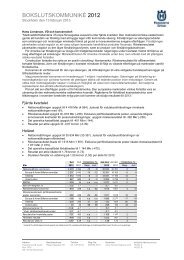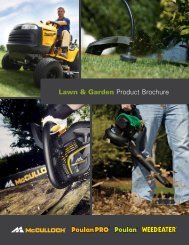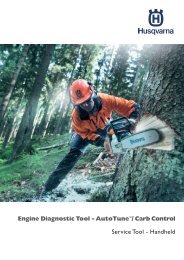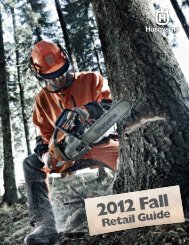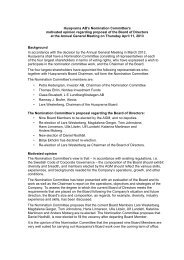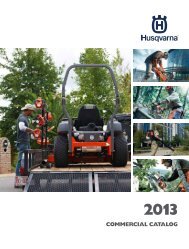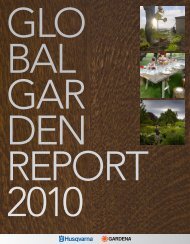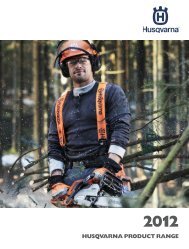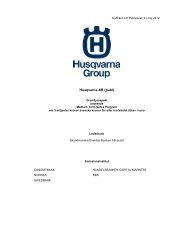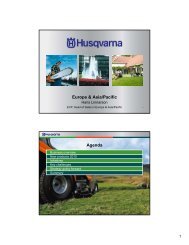Annual Report 2009 - Husqvarna Group
Annual Report 2009 - Husqvarna Group
Annual Report 2009 - Husqvarna Group
You also want an ePaper? Increase the reach of your titles
YUMPU automatically turns print PDFs into web optimized ePapers that Google loves.
118 <strong>Husqvarna</strong> <strong>Annual</strong> <strong>Report</strong> <strong>2009</strong> Sustainable development<br />
Materials<br />
Selecting materials with minimal environmental impact is a vital<br />
aspect of product development at <strong>Husqvarna</strong>. New, more environmentally<br />
adapted materials are substituted for existing materials<br />
whenever possible. The <strong>Group</strong>’s Restricted Materials List<br />
(RML) covers chemical substances in products and is a guide for<br />
selection of materials.<br />
Noise levels<br />
Over the next coming years it is expected that a number of the<br />
<strong>Group</strong>’s product categories will be subject to stricter thresholds<br />
for ambient noise. The <strong>Group</strong> monitors this trend continuously,<br />
and expectations of more rigorous regulations are integrated<br />
in product development.<br />
Recycling<br />
A vital aspect of development work at <strong>Husqvarna</strong> involves<br />
increasing the ability of recycling of components and materials<br />
such as batteries and electrical components in the <strong>Group</strong>’s<br />
p r o d u c t s .<br />
Product regulations<br />
<strong>Husqvarna</strong> products are subject to national, international and<br />
regional restrictions and regulations, primarily in terms of<br />
materials, emissions and noise.<br />
<strong>Husqvarna</strong> monitors and participates in development of new<br />
emissions criteria for two-stroke engines. The criteria for emission<br />
levels have steadily become more rigorous, and this trend<br />
is expected to continue over the next few years. <strong>Husqvarna</strong>’s<br />
expertise in technology for two-stroke engines enables development<br />
of products that meet future requirements.<br />
REACH<br />
<strong>Husqvarna</strong> maintains a dialogue with suppliers of materials and<br />
products, and regularly monitors chemical content in accordance<br />
with the requirements of the Candidate list. The <strong>Group</strong><br />
has established a steering committee that is responsible for<br />
implementation of appropriate processes and control systems<br />
in order to ensure compliance with REACH.<br />
RoHS<br />
The Europe Union’s RoHS directive regulates the use of mercury,<br />
cadmium, lead, hexavalent chrome and flame-resistant<br />
materials in electrical and electronic products. In accordance<br />
with this directive, <strong>Husqvarna</strong> has modified appropriate products<br />
and phased out prohibited substances in cooperation with<br />
suppliers.<br />
WEEE<br />
The EU’s WEEE directive regulates recycling of electrical and<br />
electronic products. <strong>Husqvarna</strong> complies with the directive’s<br />
criteria and submits the reports required in each specific<br />
c o u n t r y.<br />
RML<br />
<strong>Husqvarna</strong>’s Restricted Material List (RML) is a list including a<br />
number of prohibited (Banned) or restricted chemical substances.<br />
<strong>Husqvarna</strong> strives to minimise the amount of hazardous<br />
chemical substances in the products. The RML is a tool for<br />
all parties involved in the product development process to<br />
work in this direction and still maintain a high quality level.<br />
The RML is updated annually, and is distributed to the department<br />
for product development and to external suppliers.<br />
Product information<br />
<strong>Husqvarna</strong> has prepared environmental declarations for some<br />
handheld products. These declarations include specifications<br />
of materials, fuel consumption, type of fuel, emissions, noise<br />
levels, vibrations and packaging. They also indicate compliance<br />
with international standards and regulations, when appropriate.<br />
Product safety<br />
<strong>Husqvarna</strong> shall offer users safe products of high-quality. The<br />
<strong>Group</strong>’s comprehensive policy for product safety ensure in<br />
many ways that a product complies with safety requirements.<br />
These include extensive tests to meet specific criteria during<br />
the entire phase of product development.<br />
In order to ensure high quality and product safety, risk analyses<br />
are performed early in the product development and<br />
industrializing phases. The <strong>Group</strong> also applies the FMEA<br />
method, which is a tool for identifying possible failures, evaluating<br />
their consequences and ranking proposed measures for<br />
guaranteeing that failures do not occur.<br />
<strong>Husqvarna</strong>’s new two-stroke engines<br />
Index<br />
100<br />
80<br />
60<br />
40<br />
20<br />
0<br />
1996 1997 2001 2005 2008 2012<br />
Fuel consumption<br />
Emissions of hydrocarbons and nitrogen oxids<br />
Forecast<br />
<strong>Husqvarna</strong> maintains a program for continuous<br />
development of technology for twostroke<br />
engines. Since 1995, when obligatory<br />
criteria for fuel consumption were introduced,<br />
the consumption levels for <strong>Husqvarna</strong><br />
two-stroke engines have been reduced by<br />
approximately 20% to date. Emissions of<br />
hydrocarbons (HC) and nitrogen oxides<br />
(NOx) have been reduced by 85% during the<br />
same period. <strong>Husqvarna</strong> will continue to<br />
upgrade its two-stroke engines with new<br />
technology such as X-Torq.



